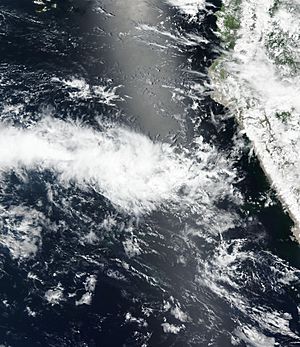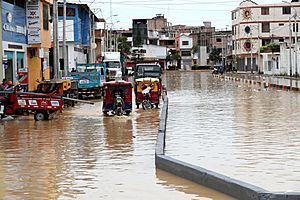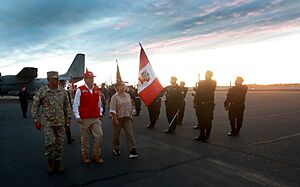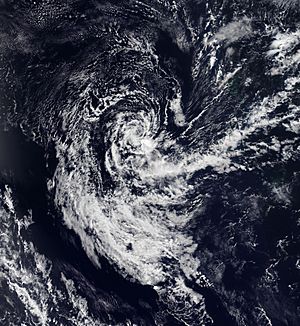Cyclone Yaku facts for kids

Yaku off the coast of Peru on 13 March
|
|
| Meteorological history | |
|---|---|
| Formed | 7 March 2023 |
| Dissipated | 20 March 2023 |
| Meteorological information | |
| Lowest pressure | 1009 hPa (mbar); 29.80 inHg |
| Overall effects | |
| Fatalities | ≥8 |
| Areas affected | Peru, Ecuador |
| Houses destroyed | >1,312 |
|
Part of the 2022–23 South Pacific cyclone season (unofficially) |
|
Cyclone Yaku was a very unusual weather system that brought heavy rains to Ecuador and northern Peru in March 2023. Peru's weather service, SENAMHI, called it an "unorganized tropical cyclone". They said it was something not seen in the area since 1983 or 1998. In Peru, this storm caused at least eight deaths. It also affected about 49,000 people and destroyed thousands of homes.
Contents
How Cyclone Yaku Formed and Moved
On March 7, 2023, SENAMHI, which is Peru's weather and water service, announced an "unorganized tropical cyclone." Their experts had noticed the cyclone forming in late February. They said this unusual weather event would stay near the Peruvian coast. However, they believed it would not directly hit cities in Peru or Ecuador.
SENAMHI also predicted heavy rain for Peru's northern coast and highlands from March 9 to 11. They also said the cyclone would not grow into a hurricane. The storm was named "Cyclone Yaku." The name "Yaku" means "water" in the Quechua language.
On March 10, Ecuador's weather service, INAMHI, reported that Cyclone Yaku was moving away from Ecuador. This meant it was no longer a direct danger to the country. In Peru, experts thought the rain from Yaku would continue until mid-March. Rain caused by warm sea temperatures might last into April. Cyclone Yaku finally disappeared on March 20.
A director from Ecuador's oceanography institute, Michael Linthon, said that changes in ocean temperatures likely helped Cyclone Yaku to form.
What Happened Because of Yaku
Impact in Peru


Many towns along Peru's desert coast do not have good drainage systems. This means even a little rain can cause big problems. Lima, Peru's capital, is one of the driest cities in the world. It usually gets only about 10 millimeters of rain each year. Cyclone Yaku happened during a time of widespread public events in Peru.
Cyclone Yaku brought extremely heavy rainfall to the Peruvian areas of Tumbes, Piura, and Lambayeque. On March 8, rain was reported in Tumbes, Piura, Lambayeque, La Libertad, Ancash, and Lima.
On March 10, the La Leche River in Lambayeque overflowed. This affected the Illimo district. About 3,000 people lost their homes, and over 1,000 houses became unsafe to live in. In La Libertad, heavy rains caused flooding in Chepén and Pacasmayo. SENAMHI reported that Lambayeque and La Libertad had more rain in 24 hours than ever recorded before. This was similar to the very strong El Niño events in 1997–98 and 2017.
By March 14, many mudslides, called "huaicos," were reported across Peru. These happened because of the heavy rain. Mudslides hit areas in Lima Province, including Ancón, Carabayllo, Chaclacayo, Cieneguilla, Comas, and Punta Hermosa. Punta Hermosa saw widespread flooding. The Piura River rose very high in the city of Piura, causing floods. The town of Quiruvilca was completely destroyed by landslides. People in Illimo, who had been flooded since March 10, said they had not received help or drinking water for almost five days. Peru's satellite, PerúSAT-1, took pictures of the damage to help with rescue efforts. On the morning of March 15, some people in Lurigancho-Chosica had to leave their homes because of the risk of more mudslides.
About 60% of homes in Catacaos were left empty because of the danger of the Piura River overflowing. Peru's disaster prevention center, CEPRENED, estimated that 592 districts across Peru were at risk of landslides or mudslides from the heavy rains. The National Institute of Civil Defense (INDECI) reported that over 45,000 people were affected. Also, 1,312 houses completely fell down. La Libertad was the area most affected. More than 3,000 homes became unsafe to live in. The damage also included 58 schools, four medical centers, over 60 kilometers (37 miles) of roads, over 94 kilometers (58 miles) of irrigation canals, and at least 118 bridges.
Peru's President, Dina Boluarte, flew over the flooded areas in Lambayeque. Some international news and TV personalities felt that the government's response to the disaster was slow or not enough.
Impact in Ecuador
Heavy rainfall hit at least 37 areas in Ecuador. Milagro, Yaguachi, and El Triunfo experienced flooding. The cyclone also damaged homes in Quevedo and Los Ríos. There were worries about a leptospirosis outbreak after 50 people got sick. Many parts of Guayaquil received a lot of rain. Roads flooded, and the electricity system was affected.
See also
 In Spanish: Ciclón Yaku para niños
In Spanish: Ciclón Yaku para niños
- Weather of 2023
- Climate of Peru
- Climate of Ecuador
- Subtropical Cyclone Katie
- Subtropical Cyclone Lexi
- Subtropical Cyclone Humberto
- List of South America hurricanes


